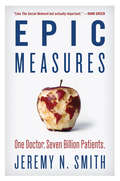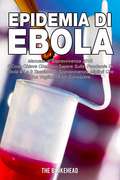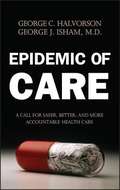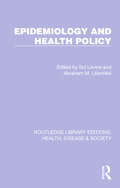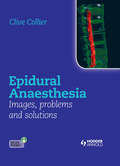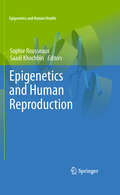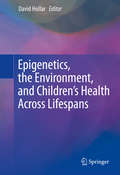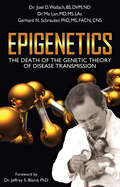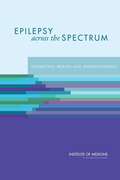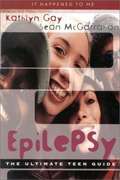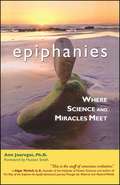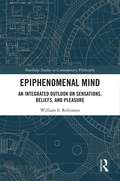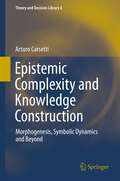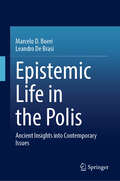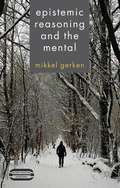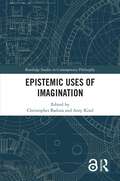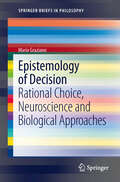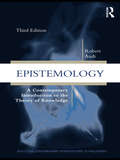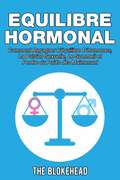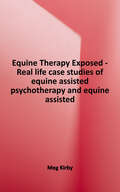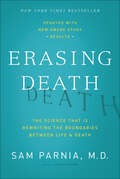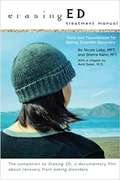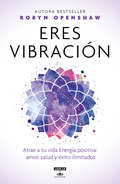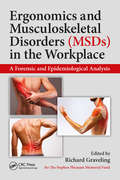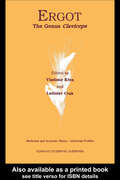- Table View
- List View
Epic Measures: One Doctor. Seven Billion Patients.
by Jeremy N. SmithMoneyball meets medicine in this remarkable chronicle of one of the greatest scientific quests of our time and the visionary mastermind behind it.Medical doctor and economist Christopher Murray began the Global Burden of Disease study to gain a truer understanding of how we live and how we die. While it is one of the largest scientific projects ever attempted—as breathtaking as the first moon landing or the Human Genome Project—the questions it answers are meaningful for every one of us: What are the world's health problems? Who do they hurt? How much? Where? Why?Murray argues that the ideal existence isn't simply the longest, but the one lived well and with the least illness. Until we can accurately measure global health issues, we cannot understand what makes us sick or do much to improve it. Challenging the accepted wisdom of the WHO and the UN, the charismatic and controversial health maverick has made enemies—as well as some influential friends, including Bill Gates who gave Murray a $100 million grant.Told with novelistic verve by acclaimed journalist Jeremy N. Smith, the story of Murray's lifelong determination to understand how we live and die encompasses wars and famines, presidents and activists, billionaires and billions of people worldwide living in poverty. It shows the human side of scientific revolutions and of revolutionary scientists—their breakthroughs and setbacks, their genius and their flaws, their champions and their critics—as they strive to bring the news of their findings to the world. This transformational effort is far from over, but the story of its genesis and impact is already an epic tale.
Epidemia di Ebola Manuale di Sopravvivenza 2015
by The BlokeheadQuando arrivano resoconti sul virus dell'ebola, molte persone diventano estremamente timorose del fatto che il Paese stia realmente avendo a che fare con un'epidemia di ebola quando invece si parla soltanto di alcuni casi isolati. A dire la verità, molte persone hanno paura che una pandemia di ebola sia dietro l'angolo. Di conseguenza, le persone stanno praticamente percorrendo ogni strada possibile per scoprire più informazioni possibili su ciò che dovrebbero fare per proteggere loro stesse e le persone a loro care. Questo manuale di sopravvivenza contro l'ebola in sette parti può aiutarti ad imparare ciò di cui hai bisogno sulla malattia e su cosa fare per proteggere te stesso e la tua famiglia.
Epidemic of Care: A Call for Safer, Better, and More Accountable Health Care
by George C. Halvorson George J. IshamRecognizing a crisis in American health care, but rejecting any solutions that are not "market-based," Halvorson (chair and CEO, Kaiser Permanente) and Isham (chief health officer, HealthPartners) explore some of the reasons for rising health care costs (absolving the HMOs for any responsibility) and make suggestions for improving the situation. Their proposed system rests largely on promoting evidence- based care for physicians and transferring greater costs to patients to improve "efficiency."
Epidemiology and Health Policy (Routledge Library Editions: Health, Disease and Society #18)
by Sol Levine Abraham LilienfeldOriginally published in 1987, this book examines the priorities of health policy in the late 20th Century and the varied approaches or strategies to foster the prevention or control of disease. Several chapters focus on specific diseases and conditions, but other areas of concern such as injuries, alcoholism, drug-abuse, occupational health and nutrition are also dealt with. The book illuminates how epidemiology can serve as a more effective basis for health policy and practice and will be of great value to students and lecturers of medical sociology, epidemiological medicine and health policy.
Epidural Anaesthesia: Images, Problems and Solutions
by Clive CollierEpidural Anaesthesia: Images, Problems and Solutions brings together the most comprehensive collection of post-block epidurograms in the world into a single volume. With accompanying X-rays and contrast injection images, it clearly explains why an epidural block has failed and provides practical advice on how to avoid complications in the future.Ke
Epigenetics and Human Reproduction
by Saadi Khochbin Sophie RousseauxEpigenetics is a rapidly expanding field in medical and biological research which concerns heritable traits that are not attributable to changes in the DNA sequence. Epigenetic mechanisms play key roles in many biological processes, and it has become clear that their disruption can gives rise to diverse pathologies in humans. Edited by preeminent experts, Sophie Rousseaux and Saadi Khochbin, this volume in the 'Epigenetics and Human Health' series discusses the role of epigenetics in human reproduction
Epigenetics, the Environment, and Children's Health Across Lifespans
by David HollarThis stimulating volume addresses vital questions about gene/environment interactions as they affect cell health from the prenatal period through later life. Beginning with a tour of epigenetic processes in the human body, the book assembles current theoretical and empirical developments across the discipline, among them transgenerational epigenetic inheritance, the effects of maternal nutrition on epigenetic change, and possible links between epigenetics and childhood obesity. Public health and policy aspects of the field are discussed in depth, with the understanding that much can be done to improve our epigenetic health as a species. And in this vein, contributors consider future possibilities, such as the reprogramming of genes to reverse cancer and other diseases. Included in the coverage: The role of environmental epigenetics in perinatal and neonatal development The epigenetic biomarker γH2AX: from bench science to clinical trials What's the risk? Dental amalgam, mercury exposure, and human health risks throughout the lifespan Post-traumatic stress disorder: neurological, genetic, and epigenetic bases Children's exposure to alcohol, tobacco, and drugs: long-term outcomes Ethical implications of epigenetics Epigenetics, the Environment, and Children's Health Across Lifespans brings real-world knowledge and applications of this increasingly important field to public health practitioners, maternal and child health researchers, and environmental health experts.
Epigenetics: The Death of the Genetic Theory of Disease Transmission
by Gerhard N. Schrauzer Jeffrey S. Bland Ma Lan Joel D. WallachWHAT IS EPIGENETICS? Epigenetics is an emerging field of science that studies alterations in gene expression caused by factors other than changes in the DNA sequence. Epigenetics: The Death of the Genetic Theory of Disease Transmission is the result of decades of research and its findings that could be as critical to our understanding of human health as Pasteur's research in bacteriology. Dr. Joel "Doc" Wallach has dedicated his life work to identifying connections between certain nutritional deficiencies and a range of maladies, formerly thought to be hereditary, including Cystic Fibrosis and Muscular Dystrophy. This nexus between nutrition and so-called genetic disease has been observed in both humans and primates, and it is the central theme of Epigenetics. To bring us Epigenetics, Wallach has teamed with noted scholars Dr. Ma Lan and Dr. Gerhard N. Schrauzer. Their collective expertise gives this book its far reaching perspective. Epigenetics is of vital importance to anyone who wants real knowledge about how the human body functions, and it provides a path for better health. Epigentics dispels the dogma and misinformation propagated by medical institutions and doctors resistant to change. Epigenetics is the beginning of a new era of well-being on this planet.
Epilepsy Across the Spectrum
by Committee on the Public Health Dimensions of the EpilepsiesAlthough epilepsy is one of the nation's most common neurological disorders, public understanding of it is limited. Many people do not know the causes of epilepsy or what they should do if they see someone having a seizure. Epilepsy is a complex spectrum of disorders that affects an estimated 2. 2 million Americans in a variety of ways, and is characterized by unpredictable seizures that differ in type, cause, and severity. Yet living with epilepsy is about much more than just seizures; the disorder is often defined in practical terms, such as challenges in school, uncertainties about social situations and employment, limitations on driving, and questions about independent living. The Institute of Medicine was asked to examine the public health dimensions of the epilepsies, focusing on public health surveillance and data collection; population and public health research; health policy, health care, and human services; and education for people with the disorder and their families, health care providers, and the public. In Epilepsy Across the Spectrum, the IOM makes recommendations ranging from the expansion of collaborative epilepsy surveillance efforts, to the coordination of public awareness efforts, to the engagement of people with epilepsy and their families in education, dissemination, and advocacy for improved care and services. Taking action across multiple dimensions will improve the lives of people with epilepsy and their families. The realistic, feasible, and action-oriented recommendations in this report can help enable short- and long-term improvements for people with epilepsy. For all epilepsy organizations and advocates, local, state, and federal agencies, researchers, health care professionals, people with epilepsy, as well as the public, Epilepsy Across the Spectrum is an essential resource.
Epilepsy: The Ultimate Teen Guide
by Kathlyn Gay Sean McgarrahanEpilepsy: The Ultimate Teen Guide dispels the myths, misconceptions, and misunderstandings about epilepsy and the people who have the disorder. It provides factual medical information and advice for teens on how to live a normal life. Stories from teens who have epilepsy show readers they can participate in normal activities. They also offer advice on whether and how to tell friends, dates, teachers, or an employer about the condition. This book concludes with an extensive list of publications, websites, and organizations, as well as an appendix that covers the Americans with Disabilities Act and how it applies to people who have epilepsy.
Epiphanies: Where Science and Miracles Meet
by Huston Smith Ann JaureguiIn a quiet moment of therapy, a breakthrough comes -- the miracle of the new. To experience an epiphany is to have sudden insight into the essential meaning of something, unleashed sometimes in exquisitely slow motion, sometimes in a flash. In an intimate, lyrical integration of the science of psychology and transcendence of spirituality, celebrated clinician Dr. Ann Jauregui introduces us to nine individuals who have undergone astonishing transformations by exploring a world quite different from the one described by our five senses. With moments of miraculous and joyful surprise, Epiphanies exposes a reality outside of everyday existence that has momentous implications for life's ultimate questions. "Shyly we venture out with these stories," Dr. Jauregui writes, "into a world where science itself is struggling to describe a realm out of time and space and language." We are the beneficiaries of these extraordinary shifts of perspective, invited into a sparkling conversation that allows us to see the potential residing in all of us.
Epiphenomenal Mind: An Integrated Outlook on Sensations, Beliefs, and Pleasure (Routledge Studies in Contemporary Philosophy)
by William S. RobinsonAccording to epiphenomenalism, our behavior is caused by events in our brains that also cause our mentality. This resulting mentality reflects our brains’ organization, but does not in turn cause anything. This book defends an epiphenomenalist account of philosophy of mind. It builds on the author’s previous work by moving beyond a discussion of sensations to apply an epiphenomenalist outlook to other aspects of mental causation such as beliefs, desires, pleasure, and displeasure. The first four chapters of the book argue for a dualistic theory of sensations and develop an epiphenomenalist version of dualism. The remaining chapters discuss propositional attitudes and valence. The author also responds to potential objections to epiphenomenalism by considering how sensations, intelligence, or understanding might be built into a robot. This book will be of interest to scholars and students in philosophy of mind who are interested in consciousness, mental causation, and how our mentality is situated in the world.
Epistemic Complexity and Knowledge Construction
by A. CarsettiThe volume as its first target aims at clarifying that peculiar entanglement of complexity, causality, meaning, emergence and intentionality that characterises the unfolding of the "natural forms" of human cognition As is well known, cognition is not only a self-organising process. It is also a co-operative and coupled process. If we consider the external environment as a complex, multiple and stratified Source which interacts with the nervous system, we can easily realise that the cognitive activities devoted to the "intelligent" search for the depth information living in the Source, may determine the very change of the complexity conditions according to which the Source progressively expresses its "wild" action. In this sense, simulation models are not neutral or purely speculative: the true cognition actually appears to be necessarily connected with successful forms of reading, those forms, in particular, that permit a specific coherent unfolding of the deep information content of the Source. Therefore, the simulation models, if valid, materialise as "creative" channels, i.e., as autonomous functional systems, as the very roots of a new possible development of the entire system represented by mind and its Reality. From a general point of view, the objectivity of Reality is also proportionate to the autonomy reached by cognitive processes. In this sense, at the level of cultural evolution, reference procedures act as guide, mirror and canalisation with respect to primary information flows and involved selective forces: they offer themselves as the actual instruments for the constant renewal of the code, for the invention and the actual articulation of an ever-new incompressibility. From an effective point of view, they appear as indissolubly linked to the successive definition of specific (and innovative) measures of the epistemic complexity. These measures cannot concern only statistical rarity (Shannon) or computational incompressibility (Kolmogorov-Chaitin), on the contrary they should also be able to take into account the coupled connection between the Source and the cognitive agent, the evolution of this connection as well as the successive constitution of meaning as symbolic form. Hence the possible (and necessary) definition of new axiomatic systems, new measure spaces, the real displaying of processes of continuous reorganisation at the semantic level. Indeed, it is only through a complete, first-order "reduction" and a correlated non-standard second-order analysis that new incompressibility will actually manifest itself. Therefore, the reference procedures appear to be related to a process of multiplication of minds, as well as to a process of "clarification" of meanings which finally emerges as vision via principles.
Epistemic Life in the Polis: Ancient Insights into Contemporary Issues
by Marcelo D. Boeri Leandro De BrasiThis book shows the interesting connections within political epistemology that can be established between ancient approaches and contemporary ones. It stems from the conviction that ancient thought can be brought into discussion with contemporary views. Although the book is not intended as an exegetical work, the authors offer detailed interpretations of ancient philosophers while taking into consideration recent specialized discussions in the scholarship with a focus mainly on the systematic aspects of those philosophers rather than on the historical ones. By exploiting insights of Ancient Greek philosophers, and providing an examination of certain intellectual attitudes and virtues that have both an ethical-political and epistemic dimension, the reader will better understand contemporary issues within political epistemology.
Epistemic Reasoning And The Mental
by Mikkel GerkenEpistemic Reasoning and the Mental integrates the epistemology of reasoning and philosophy of mind. The book contains introductions to basic concepts in the epistemology of inference and to important aspects of the philosophy of mind. By examining the fundamental competencies involved in reasoning, Gerken argues that reasoning's epistemic force depends on the external environment in ways that are both surprising and epistemologically important. For example, Gerken argues that purportedly deductive reasoning that exhibits the fallacy of equivocation may nevertheless transmit epistemic warrant from its premise-beliefs to its conclusion-belief. This view is contrary to orthodoxy according to which such reasoning must be valid. But Gerken shows how this novel and unorthodox view is integrated in a psychologically plausible account of our reasoning competencies and a general epistemological framework. What emerges is an approach to the philosophy of reasoning that is informed and constrained by both epistemology and philosophy of mind.
Epistemic Uses of Imagination (Routledge Studies in Contemporary Philosophy)
by Helen Donaghue Christopher BaduraThis book explores a topic that has recently become the subject of increased philosophical interest: how can imagination be put to epistemic use? Though imagination has long been invoked in contexts of modal knowledge, in recent years philosophers have begun to explore its capacity to play an epistemic role in a variety of other contexts as well. In this collection, the contributors address an assortment of issues relating to epistemic uses of imagination, and in particular, they take up the ways in which our imaginings must be constrained so as to justify beliefs and give rise to knowledge. These constraints are explored across several different contexts in which imagination is appealed to for justification, namely reasoning, modality and modal knowledge, thought experiments, and knowledge of self and others. Taken as a whole, the contributions in this volume break new ground in explicating when and how imagination can be epistemically useful. Epistemic Uses of Imagination will be of interest to scholars and advanced students who are working on imagination, as well as those working more broadly in epistemology, aesthetics, and philosophy of mind.
Epistemology of Decision
by Mario GrazianoThis book carries out an epistemological analysis of the decision, including a critical analysis through the continuous reference to an interdisciplinary approach including a synthesis of philosophical approaches, biology and neuroscience. Besides this it represents the analysis of causality here seen not from the formal point of view, but from the "embodied" point of view.
Epistemology: A Contemporary Introduction to the Theory of Knowledge (3rd Edition)
by Robert AudiEpistemology, or “the theory of knowledge,” is concerned with how we know what we know, what justifies us in believing what we believe, and what standards of evidence we should use in seeking truths about the world and human experience. This comprehensive introduction to the field of epistemology explains the concepts and theories central to understanding knowledge. Along with covering the traditional topics of the discipline in detail, Epistemology explores emerging areas of research. The third edition features new sections on such topics as the nature of intuition, the skeptical challenge of rational disagreement, and “the value problem” – the range of questions concerning why knowledge and justified true belief have value beyond that of merely true belief. Updated and expanded, Epistemology remains a superb introduction to one of the most fundamental fields of philosophy. Special features of the third edition of Epistemology include: a comprehensive survey of basic concepts, major theories, and emerging research in the field enhanced treatment of key topics such as contextualism, perception (including perceptual content), scientific hypotheses, self-evidence and the a priori, testimony, understanding, and virtue epistemology expanded discussion of the relation between epistemology and related fields, especially philosophy of mind, philosophy of science, and ethics increased clarity and ease of understanding for an undergraduate audience an updated list of key literature and annotated bibliography.
Equilibre Hormonal: Comment regagner l’équilibre d’hormones, la pulsion sexuelle, le sommeil et perdre du poids dès maintenant
by The BlokeheadLes hormones sont des substances chimiques sécrétées dans le sang à partir des glandes, comme les glandes hypophysaires et surrénales. Ils fonctionnent faisant partie d'un réseau complexe, appelé système endocrinien. Les systèmes endocrinien et nerveux travaillent ensemble pour former les systèmes de contrôle du corps. Un système hormonal équilibré est capable de régir correctement la croissance, le cycle du sommeil, l'humeur, le système immunitaire, le métabolisme, la faim, l'excitation sexuelle et la fertilité, entre autres. Les hormones préparent votre corps à la fois aux changements immédiats et à long terme. Depuis l'envoie d'un signal de lutte ou fuite en cas d'urgence, jusqu'à l'initiation des changements physiques de la puberté ou de la ménopause, les hormones sont les messagers de notre système de communication chimique. La compréhension des hormones nous aide à identifier les symptômes d'un système déséquilibré et à prendre les mesures appropriées pour résoudre le problème. Prenez le livre pour découvrir davantage!
Equine Therapy Exposed: Real life case studies of equine assisted psychotherapy and equine assisted learning with everyday people and horses
by Meggin KirbyIn this book, you will get a sneak peek and deep dive into the emerging professional practice of equine-assisted therapy. This unique, beautifully presented, and engaging book provides real-life case studies with diverse clients and delivers insight from one of Australia's leading education experts in Equine Assisted Psychotherapy and Animal Assisted Psychotherapy. Meg Kirby (BA, MASW, DIP. GESTALT THERAPY) is a Mental Health Social Worker of 25 years, and international education expert in equine assisted psychotherapy, author, founder, senior trainer, and supervisor at The Equine Psychotherapy Institute. When Meg is not training students from all across the globe in equine, animal, and nature-assisted psychotherapy, she spends her time caring for 12 family herd members, three cats, dog "Bear," and rabbit, Darcy... not forgetting her loving husband and two beautiful daughters, Rose and Jasmine. Meg lives and breathes the wisdom of animals and nature.
Erasing Death: The Science That Is Rewriting the Boundaries Between Life & Death
by Josh Young Sam ParniaAn examination of near-death experiences, the science of resuscitation medicine and the bigger questions about what happens to the human mind after death.Contrary to popular belief, death is not a moment in time, such as when the heart stops beating, respiration ceases, or the brain stops functioning. Death, rather, is a process—a process that can be interrupted well after it has begun. Innovative techniques, such as drastically reducing the patient's body temperature, have proven to be effective in revitalizing both the body and mind, but studies show they are only employed in approximately half of the hospitals throughout the United States and Europe.In Erasing Death, Dr. Sam Parnia presents cutting-edge research from the front line of critical care and resuscitation medicine that has enabled modern doctors to routinely reverse death, while also shedding light on the ultimate mystery: what happens to human consciousness during and after death. Parnia reveals how medical discoveries focused on saving lives have also inadvertently raised the possibility that some form of “afterlife” may be uniquely ours, as evidenced by the continuation of the human mind and psyche in the first few hours after death. Questions about the “self” and the “soul” that were once relegated to theology, philosophy, or even science fiction are now being examined afresh according to rigorous scientific research.With physicians such as Parnia at the forefront, we are on the verge of discovering a new universal science of consciousness that reveals the nature of the mind and a future where death is not the final defeat, but is in fact reversible.
Erasing ED Treatment Manual: Tools And Foundations For Eating Disorder Recovery
by Sheira Kahn-Laby Kahn Sheira Kahn Mft Nicole Laby MftThe Erasing ED Treatment Manual, a companion to the award-winning documentary aired nationally on PBS, provides a digest of information on the assessment, diagnosis, medical aspects, causes and treatment of eating disorders. It is written for mental and physical health-care providers, but clear language makes it accessible to non-professionals.
Eres vibración: Atrae a tu vida Energía positiva: amor, salud y éxito ilimitados
by Robyn OpenshawLos cambios más pequeños en tu vida, desde lo que comes hasta cómo piensas, pueden mejorar radicalmente tu estado de ánimo, tu salud general y tu calidad de vida. Eres vibración detalla los alimentos, las sustancias naturales y los hábitos de vida que elevan tus vibraciones. A través de diferentes prácticas, ejercicios y un plan détox de 7 días, aumentarás tu frecuencia vibratoria y cambiarás tu vida para siempre. Vivir en un estado de "alta vibración" es posible y te hará resistente a la enfermedad, la fatiga, el agotamiento y la depresión. Con este libro aprenderás sobre las emociones de baja vibración (miedo, ira, inercia), las emociones de alta vibración (amor, paz, gratitud) y cómo lograr vibraciones más elevadas en la vida diaria.
Ergonomics and Musculoskeletal Disorders (MSDs) in the Workplace: A Forensic and Epidemiological Analysis
by Richard GravelingWhether you call them work-related upper limb disorders (WRULDs), cumulative trauma disorders (CTDS), or occupational overuse syndromes (OOSs), these conditions are a cause of pain, disability and suffering to workers worldwide. These designations often imply that their causes are related to work, but the supporting evidence can be unclear. Transparency is important, especially when it is necessary to form a connection with work factors to obtain treatment or compensation. This book addresses the dilemma. Written by a professional ergonomist with almost 40 years of experience in workplace ergonomics, this book combines a critical summary and assessment of the epidemiological literature with an exploration of the scientific and medical evidence for possible causal mechanisms to develop well-informed conclusions on causation of a number of common musculoskeletal disorders of the upper limb and intervertebral disc injury. Although much of the book focuses on physical factors, the role of psychosocial factors is increasingly being recognized and an additional chapter reviews a number of the current theories relating to this important issue. Features Focuses on a clear and authoritative account of the evidence for the role of work in the causation of commonly occurring ULDs and disc injury Provides an up-to-date compilation of the scientific evidence, devoid of views based on assumptions or prejudice Presents a clear explanation of the most likely causal mechanisms for common ULDs and disc injuries Includes a summary of theories concerning the role played by psychosocial factors Outlines the statistical evidence in a clear and understandable manner Bridges the gap between the evidence-base in the scientific and medical research literature and the practitioner
Ergot: The Genus Claviceps (Medicinal and Aromatic Plants - Industrial Profiles)
by Vladimir Kren Ladislav CvakThis volume provides readers with biotechnological aspects of ergot alkaloid production and genetic and physiological data. Toxicology and environmental risks of ergot infection and contamination of food and forage are also detailed
